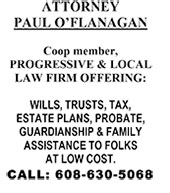by Ben Becker, Newsletter Writer
There are only a few things that are absolutely necessary for survival. Food is one of them. Though questions about what we eat may seem banal and insignificant compared to many other day-to-day concerns, the answers are not only of an immediate nature, but they also inform habits that will impact our longevity and long-term health. The proverb, “You are what you eat” is a self-evident fact, and it applies not only to our physical self, but to our cultural identity as well. When we look back nostalgically on our childhoods or the heritage of our ancestors, a special dish will often serve as a centerpiece, whether it be the traditional Thanksgiving sweet potatoes, or Grandmother’s special pierogis. It is something so quintessential and so personal and it makes up the fiber of our spiritual beings as well as the material of our physique, and yet it is so universal that its relevance extends not only to all other humans, but to all living things for that matter. For something that is so generally taken for granted and yet simultaneously of such momentous importance in shaping the rhythm of our days, how could we expect to validly quantify the value of such a thing?
Somehow, in spite of the physical necessity, and occasional metaphysical importance, we put a price on food all the time. In fact, in these times when food is super abundant, the value we associate with food is generally low, particularly in comparison to other times in history where production methods and interruption of distribution could make fulfilling this basic need quite difficult. At first blush, the drop in the cost of food may seem to run counter to the trends in meeting other primary human needs. For most of history, humans have paid little to nothing for water, whether from the stream or the tap, but now shelling out a couple dollars for a mere 16 ounces is nothing extraordinary. As populations swell and endless sprawls of development creep past urban boundaries across the globe, the cost of shelter climbs to where a roof over one’s head cannot be taken for granted. As pollutants drift from the coasts of one smog-covered continent to another, a future in which clean air might be marketed and sold at a premium so that it might be gulped and sucked from aluminum increasingly appears to be less the stuff of science fiction and more the likelihood of a foreseeable future.
Still, the resources of air, water and land which are necessary, not only for our survival but also for the production of food, continue to become less abundant, the cost of food remains low. Not only that, but it is our expectation and our demand that it should be low without regard for the ever-looming possibility that drought, flood, famine, war or pestilence could all throw a wrench in our global agro-economies and spike food prices skyward. In a world where the historical instances of mass starvation like potato blights or turnip winters are not wholly faded memories, from whence does our expectation for a hyper-abundance of a varied and surplus cornucopia stem? Why do we believe that sustenance should be cheap, fast, and endlessly available, even if we are more or less willing to recognize that quality nourishment may remain absent? This cultural mindset may very well be shattered by unpredictable or unforeseen realities of an insecure future. To understand how we developed these attitudes requires an understanding of our food supply chains and their nature, not just local economies but more often resulting from conglomerates of industrial and global scale.
GIVING BIRTH TO A BUSINESS MODEL
With an archaeological ignorance that might romantically be forgiven as faux universalism, medieval artists once painted ancient persons and exotic events garbed in the attire and settings of their own time and locale. We should not be so similarly myopic as to believe that our forebears purchased groceries from supermarkets. However, it is the advent of this modern convenience that points to our almost instinctive belief that food should be cheap, and readily available. In the 1930s, the retail grocery industry gave birth to a business model which to this day informs our habits and beliefs about purchasing food. Since that time, supermarkets have offered their products at slim margins in order to entice shoppers with low markup. Under this business model, high sales volumes are necessary to keep a retailer’s doors open, giving larger retailers a natural edge over the competition. With greater shelf space and greater buying power, big retailers can more easily offer the rock-bottom prices customers seek than a mid-size grocery store or mom and pop convenience shop. As this model remains at the heart of the industry, grocery retailers must focus on careful pricing, supply chain efficiency, and growth in order to remain relevant in a competitive industry.
In spite of the cutthroat competition, the retail grocery business is an attractive industry, worth over $400 billion in the United States alone. As recently as 2012, roughly 40,000 companies competed for a piece of this pie, but economies of scale favor the big players, and the industry trends towards larger operations dominating the retail sector. As a result, we are seeing a different kind of grocery store than we did in the past. The advent of the superstore, best epitomized by companies like Walmart and Target, combines the supermarket section with the convenience of prepared food and other merchandise all in one store. Not only has this placed these low-price retailers at the top of the list of U.S. grocery sellers, but it has transformed the model that informs store layouts, inspiring grocery retailers to incorporate new offerings from in-store buffets to coffee counters to gas stations. With more stores and an ever-increasing dominance over the dollars Americans spend on their groceries, larger retailers like Walmart, Kroger and Target also have a supernatural power to influence how their suppliers operate. Without alternative retail avenues available to growers or distributors, larger retailers can set the terms on how their suppliers price goods, ensuring that they pay as little as possible for product coming in the door. In a similar way, when consumers have fewer options for where to buy their bread and butter, the retailers are able to set the prices of their choice with impunity. Additionally, the strength of big retailers also allows them to dictate the volumes, marketing and other aspects of a suppliers operations, and often forces these suppliers to consolidate in order to stay in business. With fewer producers and distributors able to keep up, small to mid-size grocery stores are at a disadvantage when it comes to stocking food on the shelves, and face the fear of the big retailers dictating who a supplier’s partners can be.
Since coming into existence as an alternative to the conventional grocery market, the natural and organic food sector long enjoyed some immunity as a niche segment of the industry. With this independence and an increasing demand from consumers for their products, the 1990s and 2000s saw strong growth for the natural and organic foods sector. As the primary nationwide purveyor under the natural and organic umbrella, no other retailer demonstrated this prosperity quite as obviously as Whole Foods, who grew 159% between 1999 and 2004, and another 70% between 2005 and 2009. In part, this growth stemmed from gobbling up other natural food chains such as Wild Oats, a sign that even the alternative food store has to think like a big conventional retailer to be competitive. In recent years, this has only become increasingly true, as territory that was once the sacred ground of natural food stores and co-ops is infringed upon, if not altogether invaded by, the national retail and supermarket chains. If not invested in the values long-time natural and organic foods sellers have lived by, these industry insiders have only been too happy to pull the wool over the eyes of those seeking an alternative to conventional fare. A notable reaction to the co-opting of the “local” and “organic” brand took place in 2010 when the Farmer’s Market Coalition protested the use of “Farmers Market” signs in Albertson’s grocery stores throughout the American Northwest. As bigger retailers seek to swallow up the natural and organic market, often by misleading customers about what is truly locally grown or certified organic, natural and organic grocery outlets and cooperatives are increasingly feeling the squeeze of competition, not only for customers but in finding reliable suppliers as well.
AN ENTICING INDUSTRY
Despite the fierce competition resulting from the supercenters and national grocery retail chains like Kroger looking to gain more and more of the natural and organic market, the industry still remains enticing to new players. Rapidly growing chains like Festival Foods and Fresh Thyme are experimenting with locations in areas in which other companies are already well established. One of the more talked about developments in the grocery industry recently has been the buyout of Whole Foods by Amazon. In doing so, Amazon has gained access to United Natural Foods, natural foods distributor that primarily served Whole Foods, but on whom many food cooperatives in North America are also reliant. With the resources and size at Amazon’s disposal, food cooperatives are forced to speculate about how this retail giant might influence a key supplier. Amazon seems to be taking other steps to disrupt the long-established grocery business model as well, testing innovations like the Amazon Go store which could result in even less markup needed to fund customer service as human interaction is eliminated. Not all of Amazon’s innovations have proved fruitful, however. In adopting an inventory model for the Whole Foods stores that drastically curbs inventory in backstock, many shoppers are finding empty shelves where they had expected to find their favorite natural and organic brands.
FARMERS GETTING A FAIR SHAKE
While other grocery retailers consolidate and use their size to take advantage of both supplier and customer, Willy Street Co-op works hard to ensure that the farmers and producers we work with are getting a fair shake, while our Owners have the best options possible when it comes to natural, organic, and particularly local product. The Co-op’s Purchasing Director, Megan Minnick, explains how she and her team are committed to working with local suppliers, not against them, in order to get their products on our shelves. “With local vendors especially, we strive to pay a fair price to growers and suppliers rather than working to squeeze them, and finding out what growers need to make it sustainable.” Minnick admits that this means accepting that local products do not come with a rock-bottom price sticker that larger retailers might offer. However, in paying a little more, the Co-op ensures some unique features in the way it connects growers with consumers. One feature is our relationship with small, local growers who can be sure they have the necessary compensation and resources to grow the best food possible. Because of our commitment to quality, local product, Willy Street Co-op Owners can find a calibre and selection of products that are not available elsewhere. “Costco and Woodman’s operate on such a large scale that they can drive prices down with the quantities they are purchasing,” says Minnick in comparing the relatively small and nimble Willy Street Co-op to the retail giants. “A downside is that the selection is limited with bigger retailers, and treating products like commodities leads to a sacrifice in quality.” When it comes to product standards, Megan notes how much of our advantage comes from staying local: “We source a lot of local product that Costco or Woodman’s would not be able to touch. Because of our smaller size we can work with local suppliers. For produce, local product is of higher quality because of fresher, more local sourcing. We can also have greater oversight in product quality working with local suppliers. Due to our size we can really take care in what we do.”
While striving to treat our suppliers and growers fairly and simultaneously sourcing the best local product available, Willy Street Co-op also strives to keep prices affordable and in line with other community retailers: “Overall, we have found that our pricing is very comparable to stores of similar size in the area,” states Minnick, “There are some big box stores that have cheaper items, but they are generally mass-produced. There are also retailers that are at a higher price. We are right in the middle.” In order to keep prices low, Willy Street Co-op utilizes methods that give us buying power to offer deals often equal or better than other retailers. A big part of that is our membership in National Co+op Grocers (NCG), an organization dedicated to providing resources and partnership to food cooperatives across the country. By working through NCG, Willy Street Co-op can pool their buying power with other cooperatives when contracting with distributors like UNFI. The result is great sales offerings like “Co+op Deals,” which gives shoppers access to a number of staple organic items at a low price. Continued growth and expansion also provides an opportunity for the Co-op to continue to offer greater selection and the best prices possible. With three stores, more retail space, and more room for backstock, Willy Street Co-op can invest in inventory and negotiate better deals, passing these savings onto our Owners.
A DELICATE BALANCING ACT
Keeping food costs of fair for both the customer and producer requires a delicate balancing act in managing our operational expenses. Like all other grocery retailers, the Co-op is in a “penny business.” In other words, to keep our doors open, we need to make one penny in profit for every dollar of sales. When breaking down where a dollar in groceries goes, however, it’s easy to see how the Co-op prioritizes keeping as much of the other 99 cents in the community as we can, especially compared to other grocery sellers. Consider that when buying food from most other retailers, only 19 cents of every dollar spent on groceries makes its way back to the farmer or producer. Since 1950, this gap between what the grower makes and what the consumer spends has only continued to widen. In sharp juxtaposition, 64 cents of every dollar spent on local goods at the Co-op makes its way back to the farmers and producers. Because about one-third of the products we sell are local—a much higher proportion than most stores—a higher percentage of money spent at your Co-op is reinvested in our community.
In staying small and nimble enough to attend to the details of quality local product, but growing enough to stay competitive and relevant in the changing industry, Willy Street Co-op continues to be a key factor in the local and regional food economy. However, it is difficult to know what the future holds in terms of supplying Owners with quality natural and organic foods, especially when faced with the uncertainty of climate change. Both the local breadbasket of Wisconsin and warmer farming regions such as California and Mexico are seeing unpredictable growing seasons, which can impact the price and availability of produce year round. As climates that have long been dependable for producing our fruits, vegetables, and other foods change, it is difficult to predict how suppliers will be impacted, and what that will mean for the availability of many foods we consider staples in our life. Such monumental changes to our world are sure to have an impact on how our food is supplied. When our progeny look back on this time and on how our bellies were filled, it is unforeseeable how they will compare it to their own economies and methods for sourcing food.


